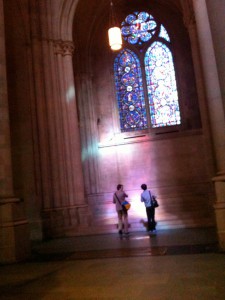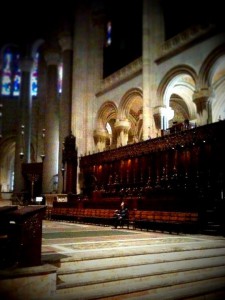We have a fairly stringent policy on photography at the Rubin Museum. Photography is allowed of our permanent collection objects in our exhibitions Gateway to Himalayan Art and (coming soon) Masterworks: Jewels of the Collection. If the items are ours, we allow you to photograph them; however, if an institution or an artist has loaned a work of art, photography is not allowed. Personally, I am in favor of being able to take photos as much as possible, but I can completely understand why somebody would not want you to take a photo of an artwork (when you work in museum administration, you get to learn all of the legal issues involved). The difficulty I have with no photo policies is that they limit the publics ability to document experience (this includes students, teachers, families, and friends who visit museums together- can you label yourself into one of these groups?).
Currently, Im teaching a course called Learning in Museums for Eugene Lang College: The New School. This semester I have 17 amazing students, and so far we’ve taken a lot of trips together around New York City, visiting various locations. Whenever we go on a trip, I like to take pictures of the students experiencing the location (I say location a lot here, because the course looks at learning in alternative spaces including museums, so weve been to museums, retail experiences, and cathedrals- so far ). I believe photography creates record of actions and emotions that students are experiencing while in the museum, and I use the photos to reflect in the classroom.
As a class we’ve started a Facebook group (the class’ choosing as the social media tool they were most likely to use) to document our trips. Most everyone has a smart phone or a digital camera and posts so far involve objects that students find interesting or of other students (and sometimes me!).

A student took a pictore of me having a conversation with another student at the Cathedral Church of St. John the Divine. I din't remember this conversation happening until I was reminded by the photo.
I personally find the pictures of the students and myself the most fascinating. The photos document conversations, moments in time, looks, staring, and more importantly, our experience as a class as we grow to know each other more (a very difficult thing to do at a college smack dab in the middle of New York City).

The Shops at Limelight (a church turned nightclub turned mini-mall in the middle of NYC): A student found her way to the top of the mall and took a photo of us looking at other classmates on the lowest level looking around. SPECTATORSHIP CAPTURED.
So far most of the places we’ve visited are incredibly photo friendly, but I always worry about a student being reprimanded for taking a photo. In today’s digital media friendly world, is it fair to separate the viewer from a lens that helps them explore objects or an experience a museum in a deeper way? Photography isn’t the only way we record artifacts of experience (we sketch and write too). How else can you document shared experiences?



